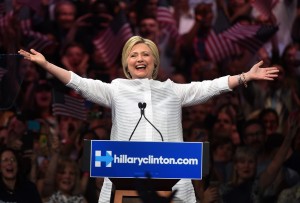di Alia K. Nardini
 Nell’ultima tornata elettorale che vedrà le primarie statunitensi concludersi il prossimo martedì, trionfano ancora, prevedibilmente, Donald Trump e Hillary Clinton.
Nell’ultima tornata elettorale che vedrà le primarie statunitensi concludersi il prossimo martedì, trionfano ancora, prevedibilmente, Donald Trump e Hillary Clinton.
Molti sostenitori del GOP hanno continuato a manifestare il proprio sostegno per Ted Cruz e John Kasich, con le stesse percentuali di quando erano in gara, ignorando volutamente il ritiro di questi candidati. La loro speranza è di convincere i conservatori a convergere su una candidatura indipendente, o quantomeno di influenzare la linea ufficiale del partito. Trump supera comunque il 70% in California, New Jersey, Montana e New Mexico, scendendo al 67% solo in South Dakota dove Cruz e Kasich hanno ottenuto il 17,1% e il 15,9% rispettivamente. Trump conquista comunque tutti i delegati in palio: con 1542 delegati in totale, e 13 milioni di Americani che lo vorrebbero come presidente, nessuno può più negargli la nomination. Il magnate newyorchese promette che renderà “il GOP orgoglioso”, seppur stia chiaramente fallendo nell’autoproclamata missione unificatrice che avrebbe dovuto assistere ad una svolta moderata nella sua campagna. Appare evidente che Trump rimarrà fedele al suo stile personalistico e populista, come hanno confermato l’attacco al giudice Curiel (che presiede un caso legato alla Trump University) “inadatto” a gestire la controversia per le sue “radici messicane”, e gli screzi con il Governatore del New Mexico Susana Martinez.
Tra i Democratici, Clinton vince in California, New Jersey, New Mexico e South Dakota, mentre a Sanders vanno Montana e North Dakota. Hillary Clinton, ora a quota 2777 contro i 1876 di Sanders, ha numericamente in pugno la nomination. Nonostante i superdelegates contribuiscano indubbiamente al suo vantaggio, anche senza di essi l’ex Segretario di Stato stacca Sanders di quasi 400 delegati. I numeri parlano chiaro: 15 milioni di americani hanno votato per Clinton, contro gli 11,5 milioni circa di Sanders. Arrvia intanto all’ex Segretario di Stato l’endorsement di Nancy Pelosi, ex leader della Camera dei Rappresentanti e ora speaker della minoranza Democratica. Si attende una dichiarazione di sostegno da parte di Barack Obama, che potrebbe arrivare questa settimana.
Volendo fare il punto su queste primarie decisamente atipiche, il successo inatteso di candidati come Trump e Sanders non manca di sollevare interrogativi interessanti per gli analisti politici così come per i cittadini. Prima di tutto, lo spazio concesso dai mezzi di comunicazione ai candidati in lizza è indubbiamente molto diverso. Tra i Repubblicani, Trump trionfa con 1898 milioni di dollari investiti in comunicazione, rispetto a Rubio, Bush e Cruz fermi tra i 200 e i 300 milioni. In campo Democratico, Sanders ha comprato la metà degli spazi pubblicitari rispetto a Clinton, spendendo 321 contro 746 milioni di dollari. Tuttavia, la copertura è stata negativa verso Clinton rispetto a Sanders, come riporta Ruth Conniff del Progressive Magazine: nei mezzi di comunicazione non solo si riportano prevalentemente notizie positive riguardo a Sanders, ma Clinton viene più criticata che applaudita. Se a trionfare sarà il principio per cui è la copertura mediatica che decreta il successo del candidato (secondo il principio “bene o male, basta che se ne parli”), l’America deve prepararsi a Trump come presidente.
Un ulteriore considerazione riguardo ai candidati anti-establishment è il confronto tra Trump e Sanders. The Donald ha mantenuto una coalizione molto eterogenea, capitalizzando su grandi eventi (rallies), pur applicando i meccanismi decisionali secondo logiche verticistiche. Ha rinunciato a strategie tradizionali come l’uso dei sondaggi, non ha mantenuto continuità nello staff, né ha steso una piattaforma politica programmatica. Ciò che ha decretato il successo dell’uomo d’affari newyorchese (la capacità di parlare alla gente comune, l’abbandono del politically correct, la campagna anti immigrazione) si è rivelato più potente della coerenza delle sue posizioni concettuali. “Get over it”, fatevene una ragione, è lo slogan che potrebbe riassumere Trump ogni volta che si trova chiamato a spiegare le sue affermazioni controverse.
Nonostante non diverrà presidente, Sanders ha ottenuto risultati importanti: grazie a lui i giovani hanno riacquistato interesse per la politica (bisogna vedere se lo manterranno, una volta che il loro candidato dovrà farsi da parte), e oggi in America si discute pubblicamente di temi che non avevano grande rilevanza in passato (uguaglianza sociale, conflitto di interessi, ricchezza nelle mani di pochi, debiti universitari). Appare indubbio che a questo punto la missione di Sanders sia quella di spostare la piattaforma politica del partito a sinistra, combattendo battaglie significative a livello locale – non certo vincere le elezioni.
Preoccupa tuttavia la poca chiarezza negli obiettivi, poiché molti sostenitori di Sanders, specie tra i giovani, hanno creduto che potesse realmente diventare presidente, ignorando i sondaggi che vedevano Clinton sempre in vantaggio sopra al 45%, per tutta la campagna (mostrando la stessa ostinazione, beninteso, con cui il GOP si rifiutava di riconoscere il vantaggio nei sondaggi di Trump, dal dicembre 2015 sempre al comando con almeno 5 punti percentuali di vantaggio).
Diventa a questo punto fondamentale per i Democratici lavorare sulla riconciliazione delle due anime del partito, liberalismo e socialismo: non per prevenire o contrastare una vittoria di Trump, ma per non cadere nella rettitudine e superiorità morale che già si diffonde tra molti tra i seguaci del Senatore del Vermont. Questo potrebbe nuocere non solo al partito, ma all’America nel complesso, andando ad acuire negli anni futuri le già profonde spaccature sociali nel paese e penalizzando i meccanismi di confronto sui quali ogni democrazia moderna si regge convincentemente.
* * *
 This past Tuesday, in the final batch of presidential primaries, Donald Trump and Hilary Clinton predictably prevailed.
This past Tuesday, in the final batch of presidential primaries, Donald Trump and Hilary Clinton predictably prevailed.
Despite the withdrawal of both Ted Cruz and John Kasich, their percentages of support have persisted as if both candidates were still in the race. Each respective candidate’s supporters only hope to persuade a significant number of conservatives to converge on an independent candidate; or, at the very least to generate enough momentum to influence the official party platform. However, Trump won hands down in California, New Jersey, Montana and New Mexico, gaining over 70% of the preferences. In fact, in his most narrow margin he dropped to 67% in South Dakota where Cruz obtained 17.1% of the vote, following was Kasich at 15.9%. Trump still won all the delegates up for grabs. His delegate count has now reached 1542.The nomination is his for the taking, and 13 million Americans believe rightfully so. The New York tycoon has promised that he will make “the GOP proud”, though he is clearly failing in his self-proclaimed unifying mission intending to accrue support from the unattained moderate conservatives. It now seems evident that Trump will persist in personalist, populist style. The attack on Judge Curiel (who presides over a case linked to Trump University), whom Trump deemed “unfit” to handle the dispute due to her “Mexican roots”, and his disagreements with the Governor of New Mexico Susana Martinez, only prove the persistence of Trump’s style.
Among the Democrats, Hillary Clinton claimed victories in California, New Jersey, New Mexico and South Dakota, while Sanders claimed Montana and North Dakota. Hillary Clinton, now at 2777 delegates, has mathematically secured the nomination; however, her lead strongly depends on superdelegates support. Without including them in the total count, the former Secretary of State tallies 2203 delegates, not too far from Sanders’ 1828. Nonetheless, numbers speak for themselves: 11.5 million Americans voted for Sanders, 15 million for Clinton. Meanwhile, former leader of the House of Representatives and now speaker of the Democratic minority Nancy Pelosi endorsed the former Secretary of State. Barack Obama’s support could follow this week.
In these very atypical primaries, the unexpected success of candidates such as Trump and Sanders raises interesting questions for political analysts as well as for citizens. First and foremost, the space given by media to competing candidates is very different. Among Republicans, Trump invested $1.898 billion in communication, compared to Rubio, Bush and Cruz (each between $200 and $300 million each). Among Democrats, Sanders has invested half in comparison to Clinton’s advertising spending, specifically $321 compared to $746 million dollars. However, as reported by Ruth Conniff of the Progressive Magazine, the coverage has been negative for the former Secretary of State. Not only does the media often report Sanders’ positive achievements, but Clinton is more often criticized than applauded. Hence, if media coverage determines the success of the candidate (according to the rule that “Any press, good or bad, is good press”), America must prepare for a Trump presidency.
A further consideration with respect to anti-establishment candidates is the comparison between the style of Trump and Sanders respectively. The Donald has maintained a very heterogeneous coalition, capitalizing on big rallies, while applying top-down decision-making mechanisms. He never resorted to traditional strategies such as the use of surveys and polls, he has not maintained continuity in the staff, nor has he drafted a programmatic political strategy. What has made the New York businessman successful (his ability to speak to the common people, the abandonment of political correctness, his anti-immigration campaign) has proved more powerful than the coherence of his conceptual positions. “Get over it”, in other words, is the slogan which could summarize Trump’s style, whenever he is called into question over his controversial statements.
Although he will not become president, Sanders has overcome monumental feats: young people have regained interest in politics (it remains to be seen whether they will keep it alive, once their candidate steps aside), and America today is discussing publicly themes that had remained unaddressed in the past (social justice, conflict of interest, wealth in the hands of a few, college debts). At this point, it is indisputable that Sanders’ mission is to move the Democratic party’s political platform further to the left, fighting significant battles at local the level – certainly not to win this election.
However, there is concern about the lack of clarity in the objectives of the Senator from Vermont, as many Sanders supporters, especially young people, really believed he could become president. Many have been oblivious to the polls that saw Clinton always at an advantage, never below 45% for the entire length of the campaign (demonstrating the same ignorance, of course, were the GOP supporters who refused to recognize Trump’s lead in the polls, always at least 5 percentage points ahead of his opponents from December 2015).
It becomes fundamental for Democrats at this point to work on the reconciliation of the two souls of the party, liberalism and socialism: not to prevent or hinder a Trump victory, but in order to avoid falling into the righteous moral superiority that is already spreading among many followers of the Vermont Senator. These feelings could be detrimental, not only to the party, but to the country as a whole, as they would sharpen the already deep social divides in today’s America and penalize the mechanisms of open dialogue on which any vibrant, modern democracy is founded.







Lascia un commento